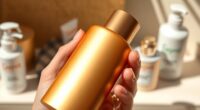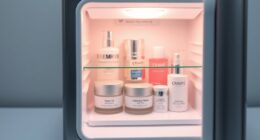To keep your tan looking fresh and last longer, focus on proper skincare, hydration, and sun protection. Apply after-sun products right after exposure to soothe your skin and lock in moisture. Stay well-hydrated, use gentle exfoliation to remove dead cells, and moisturize regularly to boost elasticity. Protect your skin with broad-spectrum SPF, limit peak sun exposure, and include foods rich in antioxidants and beta-carotene. If you want even better tips, there’s more to discover below.
Key Takeaways
- Regularly moisturize with hydrating creams containing hyaluronic acid or vitamin E to lock in moisture and preserve your tan.
- Exfoliate gently 2-3 times weekly to remove dead skin cells, ensuring an even and long-lasting glow.
- Avoid harsh soaps, hot showers, and chlorinated pools that can strip tan pigmentation and dry out skin.
- Use broad-spectrum SPF 30 or higher sunscreen and reapply frequently to protect your tan from sun fading.
- Maintain a healthy diet rich in beta-carotene, antioxidants, and water-rich foods to boost skin resilience and prolong your tan.
Apply After-Sun Products Immediately After Sun Exposure

Applying after-sun products immediately after sun exposure is vital for soothing your skin and preventing further damage. When you do this right away, you help reduce redness, inflammation, and discomfort caused by UV rays. These products calm irritated skin cells, providing instant relief from heat and sensitivity. They also deliver essential hydration, preventing dryness that can worsen sunburn pain and irritation. By applying promptly, you create a protective layer that minimizes inflammation and stabilizes your skin’s condition. This quick action supports your skin’s natural healing process, helping to prevent peeling and long-term damage. Using an after-sun product immediately after sun exposure ensures your skin stays hydrated, calm, and better prepared to recover, maintaining your tan’s vibrancy and health in the long run. Proper air quality maintenance can also enhance your skin’s recovery process by reducing exposure to pollutants that may hinder healing and impede skin regeneration. Additionally, incorporating skincare routines that include antioxidants can further support skin repair and protect against environmental stressors.
Prioritize Daily Hydration and Nourishment
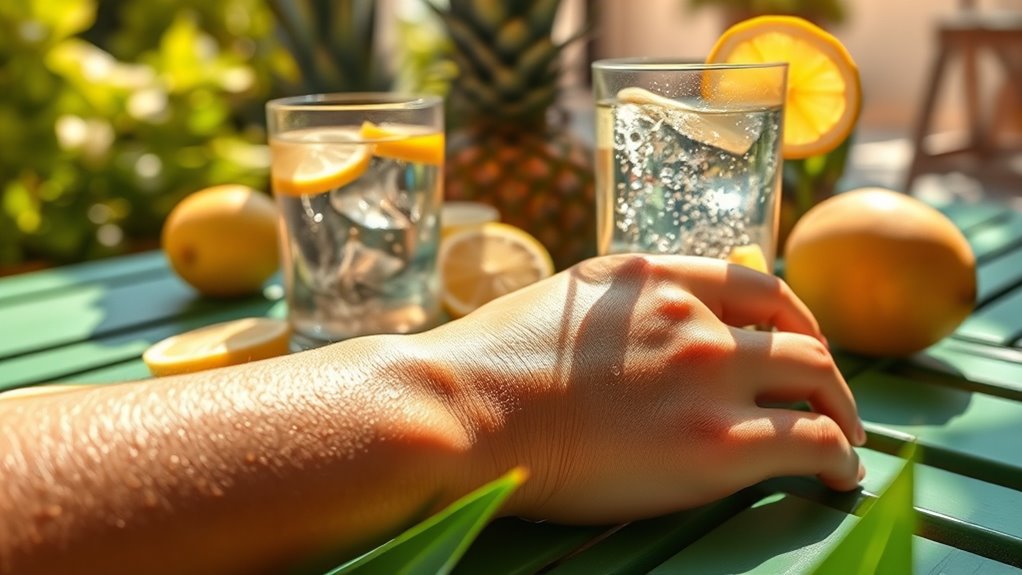
Prioritizing daily hydration and nourishment is essential for maintaining an even and long-lasting tan. When your skin stays hydrated, it applies a smoother, more uniform tan, reducing patches and flaky areas that can cause uneven fading. Drinking enough water—about 8 glasses daily—supports your skin’s elasticity and resilience, helping the tan last longer. Moisturizers with humectants like glycerin or hyaluronic acid lock in moisture, preventing dryness that accelerates fading. Nourishing ingredients such as antioxidants, oils, and vitamins boost skin repair and protect against damage, preserving your glow. Incorporating proper skincare routines can further enhance your skin’s ability to maintain its tan. Proper hydration and nourishment are your best tools for a vibrant, enduring tan. Additionally, using products formulated with hydrating ingredients can significantly improve skin moisture levels, ensuring your tan stays vibrant longer. Skin hydration plays a crucial role in maintaining skin elasticity and overall health, which supports a longer-lasting tan. Avoid harsh soaps and hot showers that dry out your skin. Instead, incorporate hydrating mists or thermal waters to refresh moisture throughout the day. Maintaining optimal skin health through balanced nutrition and gentle skincare is key to prolonging your tan. Proper hydration and nourishment are your best tools for a vibrant, enduring tan.
Incorporate Gentle Weekly Exfoliation
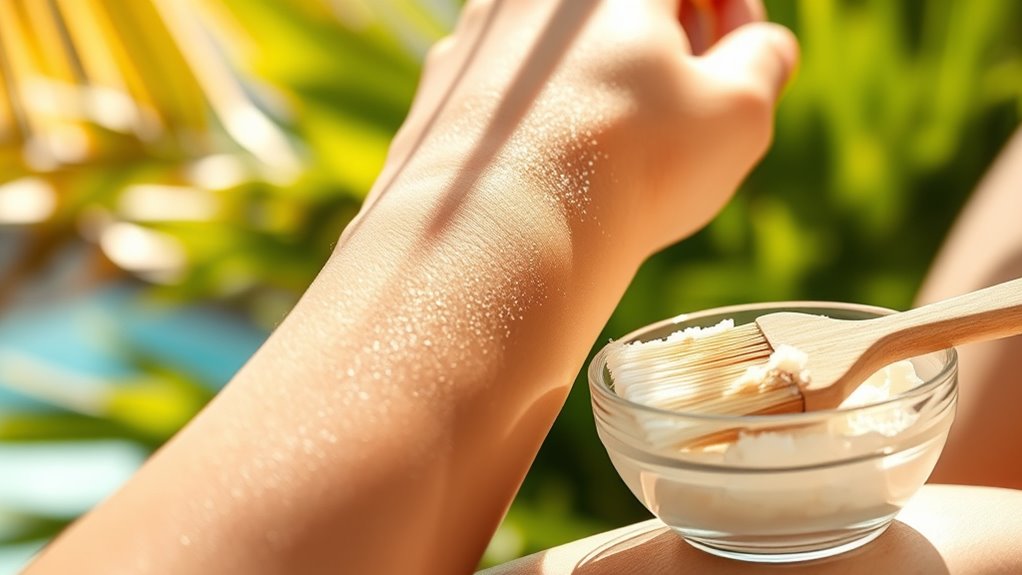
Incorporating gentle weekly exfoliation into your skincare routine is key to maintaining an even and vibrant tan. Light exfoliation removes dead skin cells evenly, preventing patchiness and helping your tan last longer. Aim to exfoliate 2-3 times a week, but avoid overdoing it, which can cause irritation. Use gentle, non-oily exfoliants like natural options such as coffee or peppermint, and steer clear of harsh chemicals. The best time to exfoliate is a couple of days after tanning, giving your skin time to settle. Always follow up with a moisturizer to hydrate and lock in your glow. Use soft loofahs or mild products, applying gentle circular motions with moderate pressure to avoid damaging your skin or stripping your tan. Incorporating proper exfoliation techniques and paying attention to skin sensitivity can also inspire creative ways to enhance your skincare routine visually. Additionally, being mindful of shelf life of exfoliants ensures your products remain effective and safe to use.
Use Sun Protection Strategically

Using sun protection strategically is essential for maintaining your tan while minimizing skin damage. Choose a broad-spectrum SPF 30 or higher to balance protection and tanning. Apply at least two tablespoons of sunscreen evenly 15-20 minutes before sun exposure, and reapply every 2-3 hours, especially after swimming or sweating. Use lightweight formulas like sprays for convenience. Cover skin with hats, sunglasses, and UV-protective clothing, especially during peak hours, to prevent overexposure. Rotate positions and take breaks in the shade to promote even tanning and reduce burn risk. Limit direct sun during peak hours (10 a.m. to 4 p.m.), and gradually increase exposure time. Understanding your skin’s response and self-care strategies can help you enjoy the sun while safeguarding your skin and prolonging your tan. Incorporating sunscreen application techniques from trusted sources can further enhance your skin protection routine.
Enhance Your Tan With Dietary Support
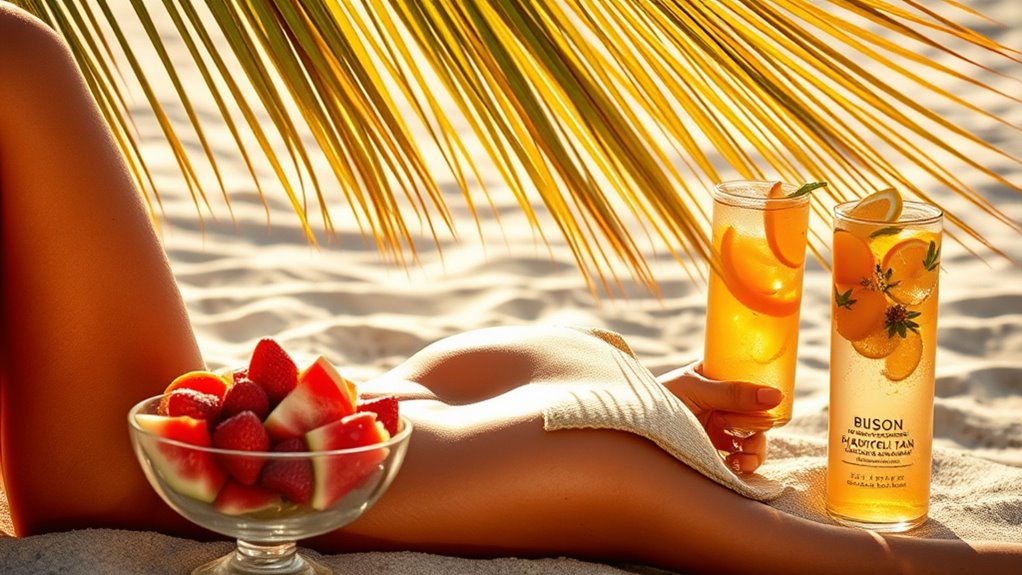
To enhance your tan with dietary support, focus on including foods that boost your skin’s natural ability to produce melanin and stay healthy under the sun. Carrots, sweet potatoes, spinach, tomatoes, and pumpkins are rich in beta-carotene, which converts to vitamin A, supporting skin health and tanning. Incorporate healthy fats from avocados, nuts, flaxseeds, fish, and olive oil to promote hydration and melanin production. Whole grains like quinoa, buckwheat, and oats provide essential nutrients that maintain your skin’s glow. Stay hydrated with water, watermelon, cucumbers, and strawberries, which help keep your skin supple and vibrant. Also, include antioxidant-rich foods such as kiwi, peaches, and dried fruits to protect your skin from oxidative damage, extending your tan’s longevity naturally. Additionally, understanding the role of AI in skin health can help in exploring innovative ways to care for your skin effectively. Recognizing self-care practices can further enhance your overall skin health and tanning results. Maintaining a balanced diet that includes these nutrients supports healthy skin function, which is essential for achieving a lasting tan. Incorporating regional dietary habits can also optimize your skin’s resilience and appearance under sun exposure. Being mindful of sun protection strategies ensures your skin stays healthy while you achieve that beautiful glow.
Opt for Self-Tanning Products to Extend Your Glow

Opting for self-tanning products is an effective way to maintain and extend your sun-kissed glow without additional sun exposure. Self-tanning lotions hydrate and firm your skin while delivering a natural bronze tone, like Norvell’s products. Tan extenders, such as Studio Glow’s Extended Glow moisturizer, can add 2-4 days to your tan’s lifespan. Products with higher DHA content, like GlowPro’s 6%, help sustain darker tans longer. Many options feature natural, organic ingredients that nourish your skin and ensure a healthy tanning experience. These products are convenient, available in various sizes for daily use or travel. Additionally, vegan and cruelty-free choices like Studio Glow support ethical beauty habits. Using these products regularly keeps your glow vibrant, smooth, and natural-looking without the need for additional sun exposure. Incorporating skincare routines that include moisturizing and exfoliating can also enhance your tan’s longevity and ensure a more even, radiant appearance. Proper application techniques can further optimize the results and prolong your tan’s duration. Moreover, choosing products with advanced technology can improve application uniformity and overall effectiveness.
Maintain Skin Elasticity With Proper Moisturizing
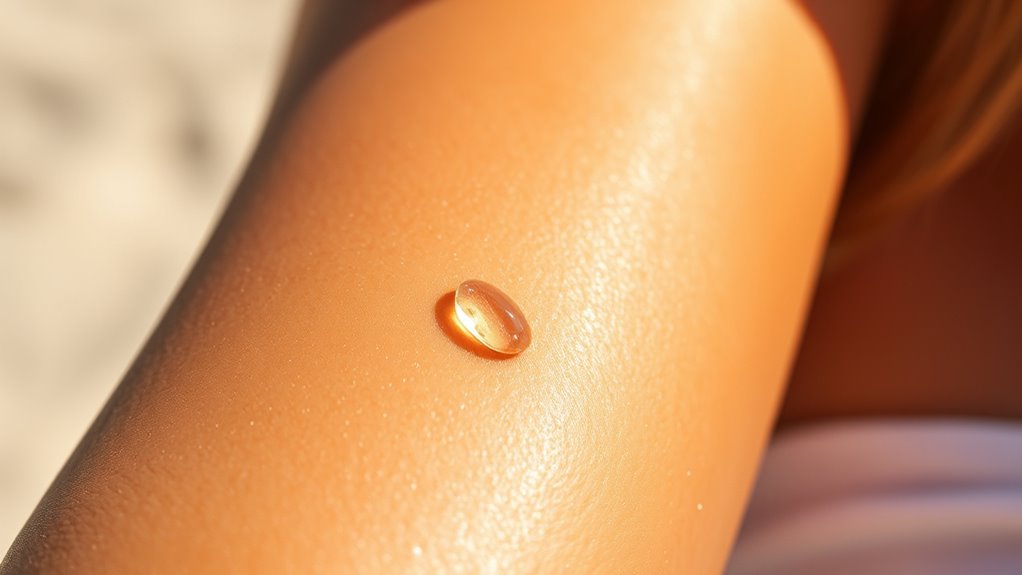
Maintaining your skin’s elasticity is essential for preserving a youthful, firm appearance, especially when you want to extend the life of your tan. Regular moisturizing keeps your skin hydrated, preventing dryness that can cause dullness and loss of firmness. Using products with hyaluronic acid and vitamin E helps lock in moisture, repair skin damage, and support elasticity. Incorporate a daily routine with hydrating creams or body butters, and apply immediately after showering to maximize absorption. Staying well-hydrated by drinking water and eating water-rich foods like cucumbers boosts your skin’s ability to stay elastic. Hydration plays a crucial role in maintaining skin health and elasticity, especially when exposed to environmental stressors. Using a humidifier in dry environments also helps maintain moisture levels. Additionally, choosing proper camping gear with breathable materials can help protect your skin from environmental stressors when outdoors. Consistent moisturizing ensures your skin remains supple, resilient, and capable of holding onto your tan longer.
Avoid Harsh Skin Treatments That Can Damage Your Tan

Harsh skin treatments can quickly damage your tan and shorten its lifespan. Exfoliating aggressively with coarse scrubs or strong chemical exfoliants strips away the top skin layer, which holds your tan pigment, causing it to fade faster. Chemical peels with potent acids, like TCA or high-strength glycolic, remove layers of tanned skin and can lead to uneven fading or discoloration, especially if your skin is sun-damaged. Hot baths, long showers, and chlorinated pools also accelerate tan loss by stripping natural oils and dehydrating your skin. Harsh soaps and cleansers with strong detergents or alcohol can dry out your skin, making your tan fade prematurely. Avoid treatments that cause inflammation or irritation, like aggressive waxing or laser procedures, to keep your tan intact longer.
Practice Smart Sun Exposure Habits
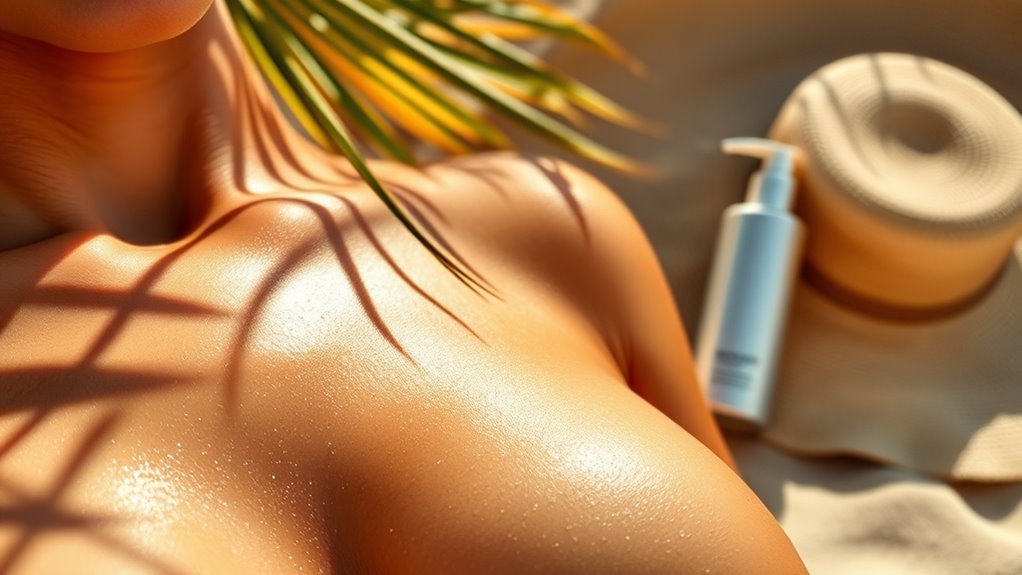
Practicing smart sun exposure habits is essential for preserving your tan while minimizing skin damage. Limit your total sun exposure to around 50 sessions annually to keep your skin healthy and your tan vibrant. Avoid sun between 10 a.m. and 4 p.m., when UV rays are strongest. Start with 15-minute sessions in the morning, gradually increasing by 10 minutes daily, especially if you have lighter skin. After reaching your desired tan, cut back on exposure to maintain color without overexposing your skin. Take shade breaks during peak UV hours to protect your skin while extending your tan. Remember, using broad-spectrum SPF 30 sunscreen, reapplying regularly, and preparing your skin beforehand helps guarantee a safe, effective tanning routine that keeps your glow longer.
Frequently Asked Questions
Can Certain Skincare Ingredients Accelerate or Fade My Tan?
Certain skincare ingredients can indeed accelerate or fade your tan. Exfoliants like citric acid, glycolic acid, and papaya enzymes remove tanned skin layers, making your tan fade faster. Retinoids and vitamin C also promote skin renewal and lighten pigmentation. If you want to preserve your tan, avoid harsh acids and exfoliants immediately after sun exposure. Instead, use gentle, hydrating products to maintain your glow longer.
How Does Climate or Humidity Affect My Sunless Tan Longevity?
The current question is about how climate and humidity impact your sunless tan, and trust me, humidity can speed up your tan’s life like a fire in dry grass. When it’s humid, moisture breaks down DHA faster, causing your tan to fade quicker. Hot weather destabilizes formulas, while water exposure from sweat or rain strips color. To keep your glow longer, shield your skin and store products in cool, dry places.
Are There Specific Fabrics or Clothing That Help Preserve a Tan?
You should choose fabrics and clothing that help preserve your tan by blocking UV rays and reducing friction. Opt for dense, tightly woven fabrics like denim, canvas, or synthetic fibers, and wear darker or bright colors that absorb or reflect UV rays. Loose-fitting clothing with high UPF ratings offers better protection. Avoid sheer, stretched, or wet fabrics, as they let UV rays through, causing your tan to fade faster.
Can Supplements or Vitamins Enhance My Skin’S Natural Tanning Ability?
Think of your skin as a canvas waiting for vibrant color. Supplements like beta-carotene, copper, and tyrosine actively boost melanin production, helping you tan faster and deeper. Vitamins C and E protect your skin from damage, preserving that glow. By combining these with a healthy diet and sensible sun exposure, you enhance your natural tanning ability. Just remember, supplements support, but don’t replace, safe sun practices.
How Long Should I Wait Between Sun Exposure and Applying After-Sun Products?
You should wait about 30 to 60 minutes after sun exposure before applying after-sun products. This allows your skin to cool down and guarantees the moisturizer fully absorbs, maximizing its soothing effects. Applying too soon may trap heat or hinder absorption. Make sure your skin isn’t still hot or red, and choose products with soothing ingredients like aloe vera or hyaluronic acid to help your skin recover efficiently.
Conclusion
To keep that beautiful glow shining longer, treat your skin with gentle care and smart habits. By nurturing your skin and being mindful of sun exposure, you create a subtle foundation for your tan to gracefully linger. Remember, a touch of extra effort now can help your radiant appearance softly fade, leaving behind only a gentle reminder of sunny days. Embrace these habits, and your tan will quietly maintain its charm a little longer.

